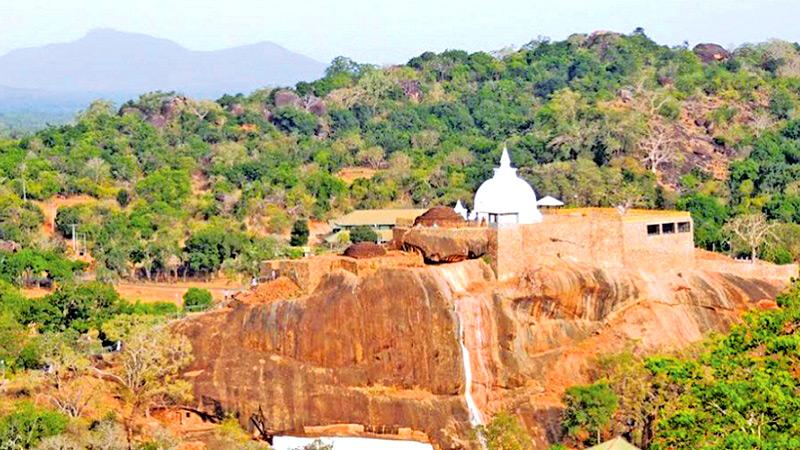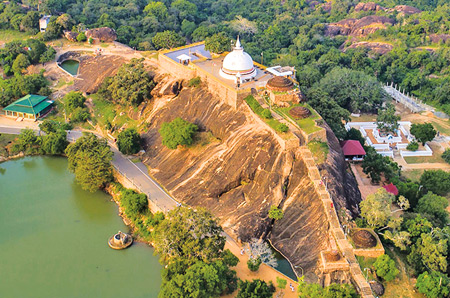
There are only four days left for the Poson Poya Day, an annual festival held by Sri Lankan Buddhists celebrating the arrival of Buddhism in Sri Lanka in the 3rd Century BC. As we approach Poson Poya Day, we are most reminded of Mihintale in Anuradhapura and Situlpawwa Raja Maha Vihara in the Southern Province. This is because these places are full of devotees during the Poson season, although it will not be the case this year given the situation which has arisen with the spread of the Covid-19 pandemic.
Situlpawwa Rajamaha Vihara is located in the Yala National Park which is spread over the Hambantota District of the Southern Province and the Moneragala District of the Uva Province. There are two main roads to access this ancient site. One of them falls from Tissamaharama across the Yoda Kandiya Road in the middle of the Yala Forest. The other road is from Kataragama, where the location can be reached by passing about 18 kilometers through the Yala Forest.
Harsh climate
 Known as the Central Sacred Site of the Yala Forest, the Situlpawwa Temple continues to thrive in the harsh climate experienced by the Yala Forest for most of the year. The rains that fall in the Yala Forest at the end of the year bring fertility not only to the beautiful environment of Situlpawwa but also to the entire forest. During the rainy season, the forest around Situlpawwa is adorned with beautiful trees and vines that glow in various shades ofgreen, creating a beautiful view all around.
Known as the Central Sacred Site of the Yala Forest, the Situlpawwa Temple continues to thrive in the harsh climate experienced by the Yala Forest for most of the year. The rains that fall in the Yala Forest at the end of the year bring fertility not only to the beautiful environment of Situlpawwa but also to the entire forest. During the rainy season, the forest around Situlpawwa is adorned with beautiful trees and vines that glow in various shades ofgreen, creating a beautiful view all around.
Situlpawwa is one of the most important temples in the ancient Magampura Kingdom. The ruins that can be seen in the Yala National Park bear witness to the rich prosperity of the area in the past. According to the chronicles, in the time of King Devanampiyatissa, ancient Kataragama was an independent, local dynasty of Kataragama Kshatriyas. Later, with the establishment of the Kingdom of Magampura in the 3rd Century BC by Mahanaga, the area around Sithulpawwa also belonged to the Kingdom of Ruhunu Magampura.
Situlpawwa is a place of historical and prehistoric significance that has been known as a Buddhist monastery since pre-Christian times. This place is mentioned in literary sources as well as in epigraphic sources. Situlpawwa is also referred to as Chittala Pabbata in literary sources and "Chithala Pavatha" and Chithala Pavama in epigraphic sources.
They mean the "rock that attracts the minds" and the natural beauty of the place may have contributed to these names. A visitor to the Maha Situlpawwa and the Kuda Situlpawwa Rocks and the surrounding environment would undoubtedly be amazed of the place. Wonderful landscapes that can be seen from an invisible dimension, towering cliffs and attractive views, as well as blue water pools that offer a truly beautiful setting.
It was also home to a cave that helped 12,000 Arahants to meditate in the ancient times. The set of caves, which are located around, create a serene environment that calms the mind of anyone who visits there. According to sources, history of the historical era of Situlpawwa begins with the arrival of Mahinda Thero. Also, according to the Mahavamsa, the Situlpawwa Temple was started by King Kavanthissa of Ruhuna. During the reign of King Kavanthissa, a great development may have taken place in this place under his patronage. The kings of Ruhuna may have made a special contribution to such temples as Tamil rule had been established in the Rajarata area of Ceylon at that time.
It is believed that Tissamaharama and Situlpawwa temples in particular were the two main temples. This is further confirmed by the fact that after the end of King Dutugemunu's invasion of Rajarata, those who were involved in it also contributed to the development of Buddhism in the country to the best of their ability. Accordingly, the names of the four such persons who contributed to the Situlpawwa temple are confirmed by the inscriptions bearing their names.
Monastery complex
It is also said that this place was a very crowded monastery complex even during the Walagamba period. According to ancient sources, the site was inhabited by 1,2000 Arahants at the beginning of the period of severe drought and famine called "Baminitiasaya".
Accordingly, the cave occupies a prominent place among the ancient ruins of the Situlpawwa Temple. Based on these ancient facts and the existing ruined buildings, it can be inferred that a large number of people lived in this place during the period of 03 BC and no other monastery complex with so many drip caves in one monastery complex has been found anywhere else in Sri Lanka.
All the kings except King Kavanthissa who patronised the Situlpawwa temple were in Anuradhapura Kingdom. Among them is King Vasabha. He was a king who was a great patron of the temple in the 1st century. According to the Mahavamsa, King Vasabha built 10 stupas on the main rock of the Situlpawwa Temple. (Mahavamsa: 35: Ch. 81: 82 stanzas) Archaeological ruins confirming this Mahavamsa story can still be seen in Situlpawwa.
In addition to the stupas built by King Vasabha, many other stupas built by various kings under their patronage can still be seen on the hills surrounding the Situlpawwa. Situlpawwa also holds a special place among the monastic complexes with the largest number of stupas found in a single place. In the past, there were a large number of large and small stupas in the area where the monastery complex had been spread.
King Gajabahu, a grandson of King Vasabha, was also one of the patrons of the Situlpawwa Temple. According to chronicles, Situlpawwa was still one of the leading Buddhist temples in Ceylon by the 5th Century. Two beautiful Bodhisattva statues can be seen at the site and two ancient stupas on the main rock and the small rock have been restored. It is believed that the large cave and its paintings, especially on the eastern slope of the main rock, represent the early period of the Anuradhapura period.
The paintings found in Situlpawwa are an illustration of the paintings of the Anuradhapura period. These paintings, painted on a very thin plaster under the ditch of the cave, have now been severely destroyed. Among the recognisable parts of these paintings is the painting of a herd of Jungle fowl. This line of Jungle fowl, which is very rare to be found anywhere in the country, is depicted running one behind the other. In addition, a window (with three sticks), a figure of a deer with horns, two statues of the Buddha and a part of an arm, as well as an image of a deity in the sky above can be easily identified. The colours and traditions here are very similar to those of Sigiriya paintings.
Bodhisattva images
Among the Bodhisattva images found in Sri Lanka, the two Bodhisattva images of Situlpawwa are of particular importance. These Bodhisattva images have been identified as belonging to the Avalokiteshvara Bodhisattvas. Avalokiteshvara Bodhisattvas are represented in two ways. That is, the princely form and the yogic form. One of the two statues here has no head. It is a statue of a prince. The hands of both statues have been broken and destroyed near the elbows.
However, there is no clear mention of Situlpawwa in the chronicles as well as in the archaeological sources after the 7th-8th centuries AD and it can be assumed that the Situlpawwa temple gradually became forgotten after the Anuradhapura period. Situlpawwa may have gone hidden in the Yala Forest, especially due to the migration of the Sinhala kingdom from Rajarata to the southwest and the fact that Rohana was not as important as a regional kingdom. Situlpawwa, isolated in the middle of the forest, was later highlighted in his book by the Englishman Leonard Woolf in the early twentieth century. Later in 1917 Kavikulathilaka Kalahe Sri Rathanajothi Thero came to this place and developed it with the permission of the British Government under which the country was at that time.
